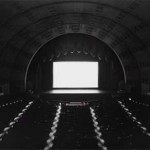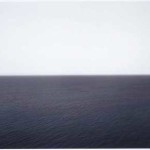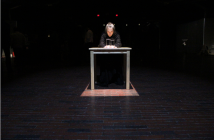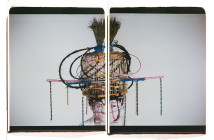The Museum of Fine Arts currently has a photography show tucked away in the Japanese print gallery called Photographs by Hiroshi Sugimoto: The Sylvan Barnet and William Burto Collection. Though it is surprising to see a major figure in contemporary art contextualized primarily as a "Japanese" artist, the intimacy of this small show does well to highlight the work. Comprised mostly of two well known series by Sugimoto, both begun in the late 1970s, the displayed prints are relatively small, a far cry from his enormous "Architecture in Time" prints hanging in New York's Sonnabend Gallery last year.
Well known for the extraordinary quality of his black and white prints, Sugimoto is no traditionalist in the Adams/Weston vein. His images are as much about what photography does and how photography works as what is within the photograph itself. One photographic series is of seascapes, with a horizon line perfectly bisecting the sea and sky. Appearing ordered and systematic at first glance, the seascapes come to challenge the rigid impositions of formalism. Each seascape is carefully titled of its location, "North Atlantic Ocean - Cape Breton Island," but these determinations reveal an absurdity, for there is only the sea and sky to be seen.
Furthermore, Sugimoto punctures the descriptive power of the camera with his lengthy exposure times. Using a neutral density filter on his lens to cut his film speed down to below one ASA, each image can take up to three hours to expose. As a consequence, the seascapes not only represent the impossibility of describing a landscape in constant flux, but the blurred horizons remind of how the horizon is only a visual phenomenon. The blurred elements of the seascapes also serve to enfeeble the viewer with the same hypnotic qualities of Pierre Huyghe's buildings in fog and Anish Kapoor's "Whiteout" sculptures.
Across from the seascapes is the movie theatre series, where Sugimoto has photographed the interior of grand old American movie theaters (and some drive-ins) using only the illumination of a projected film to expose his images. These photographs again provide a container for time to exist, in this case, the specifics of the length of a movie. Cinematic light becomes a creative object, shaping and defining the historical phenomenon and architectural dramas of a theater such as Radio City Music Hall, which exists as a cathedral of vision.
The most unusual images of the show are Sugimoto's portraits. Other well-known series of photographs are portraits of wax mannequins, but displayed here are three portraits of live people. Two are self-portraits, another is a double portrait of the collectors, Sylvan Barnet and William Burto. Sugimoto sheepishly apologizes to his collectors for making them look waxen, but they appear innocuously heroic, nonetheless. The two self-portraits are similar to his seascapes in how they simultaneously reveal and conceal. One has a standing Sugimoto, turned diagonally to the camera wearing glasses that strongly reflect directional light. His face becomes distorted as a result, but his personal confrontation with light is the same as the one imagined behind the camera in all of his photographs.
The other self-portrait, which is also tongue-in-cheek, is of the artist standing in a lab coat, presenting a seascape image on an easel like a specimen, the whole scene taking place on a rooftop. His face is blurred, distorted, everything else is crisp and clear, including his hand firmly in his pocket. An artist, a huckster, a scientist of light, Hiroshi says, "hah hah."
----
*it is important to note that Sugimoto will be speaking at the Museum of Fine Arts on March 9th at 7pm.
- Hiroshi Sugimoto, Aegean Sea, Pillion II, 1990
- Hiroshi Sugimoto, Radio City Music Hall, New York, 1978
- Hiroshi Sugimoto, Ionian Sea, Santa Cesarea I, 1990
Links:
The Museum of Fine Arts, Boston
"Hiroshi Sugimoto: The Sylvan Barnet and William Burto Collection" is on view January 11 - June 29, 2005 at The Museum of Fine Arts.
All images are courtesy of The Museum of Fine Arts.







